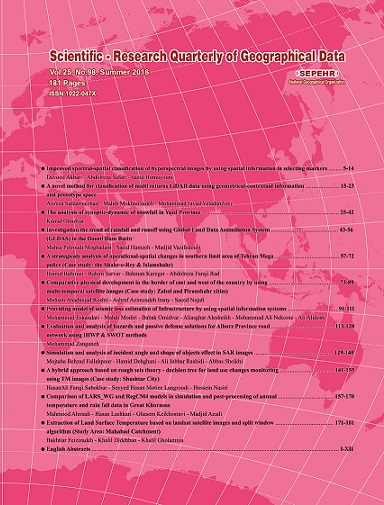Document Type : Research Paper
Authors
1 M.Sc. student of watershed engineering, Faculty of agricultural technology & natural resourcesو University of Mohaghegh Ardabili
2 M.Sc. student of watershed engineering, Faculty of agricultural technology & natural resources University of Mohaghegh Ardabili
3 Professor (Assistant) Department of Rangeland and Watershed Management, Faculty of Agricultural Sciences and Natural Resources, University of Mohaghegh Ardabili
Abstract
Introduction
Drought as a natural deficiency of precipitation over aperiod of time is a serious hazard to environment andthe lives of living species. Spatial-temporal variability of wetand dry spells will affect availability of water resources andmanagement plans. Therefore, the lack of opportunity and sufficient resourcescauses serious damage in the time of drought occurrence. Droughtdisaster management includes a set of reactive responses which canreduce or mitigate the consequences of drought events. Thus, theanalysis of drought indices is necessary to predict and assessthe spatial and temporal variability of this phenomenon. The StandardizedPrecipitation Index, as a well-known meteorological drought indicator, isthe capability of estimating various drought characteristics and can beused to analyze past droughts and predict future droughts returnperiods. The Standardized Precipitation Index was selected due to itssimplicity and ability of calculating the duration of droughtevents and the severity of drought and mildew.
Materials & Methods
In this study, drought condition and its spatial-temporal variations were investigated in Kurdistan province, Iran, using the Standardized Precipitation Index (SPI) calculated by DrinC software in different 3, 6 and 12 month time scales. Toward this attempt, the monthly precipitation data of nine synoptic stations in Kurdistan province including Sanandaj, Saghez, Zafarabad, Marivan, Baneh, Ghorveh, Bijar, Kamyaran and Dehgolan were obtained. The maximum available recorded data were used for analysis. The maximum and minimum values of the SPI index in the 3, 6, and 12-month scales were defined in the study period. Also, spatial distribution of drought condition based on the 12-month index was presented alternately in some years of the study period. Then, the most important characteristics of wet and dry periods, including the total number of wet and dry months, were determined in different drought classes. In this research, the inverse distance weighting method was used to determine the spatial pattern of drought characteristics in the study area and zoning maps.
Results & Discussion
The results of the study indicated that the severe drought in the three time scales has occurred across Dehgolan station in 2005-2006. The longest period of drought occurrence with high severity level with 17-month length was related to Qorveh station. The results of the study approved the variability of drought occurrences across the study area in different time scales.
Table. Some characteristics of wet and dry spells based on 6-month SPI values in the selected stations of Kurdistan province
Station
statistics
Sanandaj
Saghez
Zafarabad
Marivan
Baneh
Ghorveh
Bijar
Kamyaran
Dehgolan
Max
1.3
2.0
2.2
1.8
1.5
1.6
1.7
2.0
1.3
Min
-2.2
-2.6
-1.7
-2.3
-2.0
-1.7
-2.2
-3.0
-2.2
Average
0
0
0
0
0
0
0
0
0
Dry months
10
17
7
15
9
9
14
13
10
Wet months
6
11
9
11
7
7
14
11
6
Exceptionally wet months
0
0
1
0
0
0
0
0
0
Extremely wet months
1
1
1
2
1
2
1
1
0
Severely wet months
4
3
0
2
3
0
5
2
2
near normal months
20
20
12
17
10
10
17
19
11
Severely dry months
2
1
1
2
1
3
1
0
1
Extremely dry months
0
2
1
2
1
1
3
1
1
Exceptionally dry months
2
1
0
1
0
0
1
1
1
Finally, the zoning maps of the study area indicate that, there is a higher wet spell occurrence in the North and West regions, while the Eastern parts of the province experienced more severe droughts. Accordingly, Dehgolan station has the first priority in terms of drought severity among stations and the lowest drought severity was defined in the Zafarabad (Dyvandreh) station.
Conclusion
It can be concluded that, the Dehgolan and Divandareh stations were identified as the highest and lowest priority in terms of drought hazard occurrence in considered temporal time scales. As a result, drought crisis management and prediction can be one of the effective measures in reducing the damages of this climatic phenomenon, especially in drought-prone areas. It is suggested that other drought indicators be used to identify drought characteristics and the results be compared to obtain a comprehensive understanding on the drought severity and extent over the study area.
Keywords

